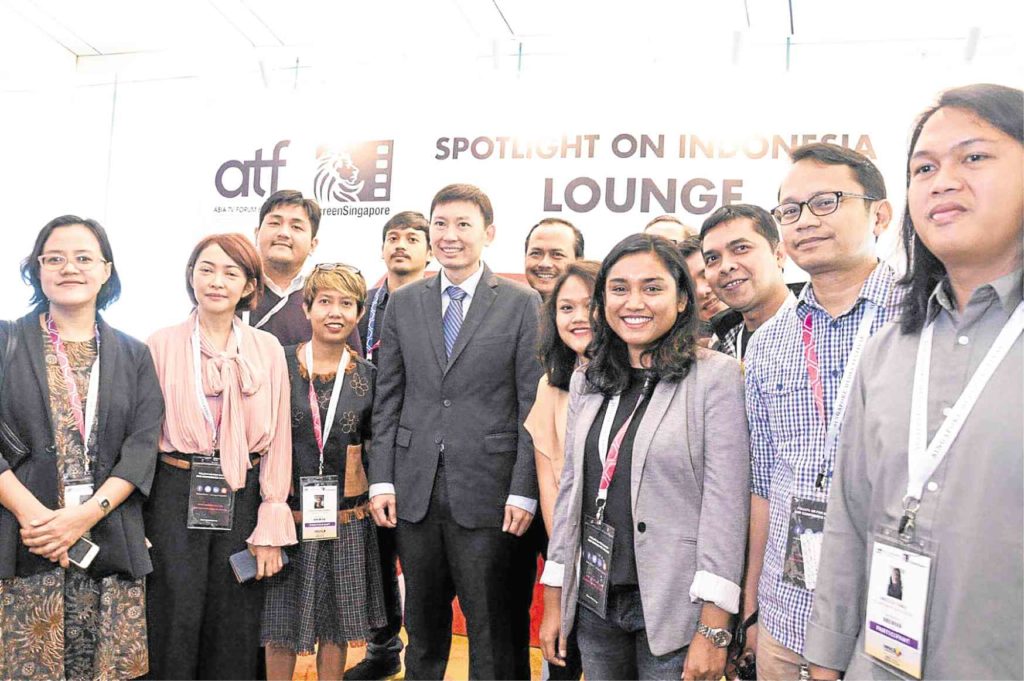
Chee Hong Tat (center), Singapore’s senior minister of state in the Ministry of Trade and Industry and Ministry of Education, with some of the delegates to the Asia TV Forum and Market conference and ScreenSingapore—PHOTO COURTESY OF SINGAPORE MEDIA FESTIVAL
Blindingly fast advancements in technology may have irrevocably changed the media landscape, from television to newspapers to movies and even advertising. But one skill has not lost its value in the face of such rapid and radical evolution—telling a compelling story.
Indeed, the experts and the market movers in the media industry that gathered during the most recent Asia TV Forum and Market conference and ScreenSingapore were one in saying that there should be a renewed focus on telling a good story, if they want to have any hope of capturing the readers’ or the viewers’ attention in the dauntingly fragmented industry.
And Asia is a treasure trove of fascinating stories, which are ripe for more exposure overseas, thus the theme “Celebrating Asian Storytelling” of the fourth edition of the Singapore Media Festival, hosted by the Info-communications Media Development Authority (Imda) and supported by agencies such as the Singapore Tourism Board.
According to Chee Hong Tat, Singapore’s senior minister of state in the Ministry of Trade and Industry and Ministry of Education, Asian content was “doing well internationally.”
He cited the warm response to the Korean drama “Descendants of the Sun,” which has been translated into 32 languages, and the Indian historical epic “Baahubali 2” that was released in 9,000 theaters worldwide. Then there is Singaporean filmmaker Kirsten Tan, who brought to life a bittersweet tale of a man traveling across Thailand with his elephant and captured the hearts of a Japanese audience.
“These successes show that Asian stories are gaining popularity with global audiences,” he said during his speech to open the twin events that brought together over four days some 5,200 professionals in the television, film and digital entertainment content industry.
Technology has been a major factor behind this growing popularity of Asian stories, he said.
As more people get Internet connectivity, the world opens up to content produced outside their borders.
“The internet has surpassed traditional distribution channels to become the dominant way where many consumers access media content, including a diverse range of local and foreign entertainment choices such as films, TV shows, podcasts, audiobooks and virtual reality. In such an environment, skilled storytelling will be even more critical to attract viewers,” he said.
Singapore is taking care of its own, with the Imda supporting a branded content developing training program where participants will learn to deliver professional content pitch, realizing the need to upgrade the skills of digital media content creators on branded content creation, and also aiming to encourage local brands to adopt such content in their marketing strategy.
Debbie Evans, Reed Exhibitions president for Southeast Asia and Australia, echoed the sentiment that content was king. Reed Exhibitions produces the ATF and ScreenSingapore annually.
“Content is really what attracts the audience,” Evans said, and the need to deliver the right content must be guided by the right set of data, to know exactly what kind of material would resonate with what kind of audience.
“We live in a world of big data and our industry is no exception. With Asia being one of the world’s most diverse regions, the myriad of content, channels, audiences and platforms has resulted in a large volume of data. Each holds a vital insight into the audience’s propensity to tune into a particular content and platform. It also forms the backbone for future projections and opens doors for exploration of new channels, formats and business models,” Evans said.
What exactly is good content or good story? For many experts, it all boils down to three factors: “interesting, useful and current.”
As to where that content can be most effective, Jan Rezab, founder and chair of Socialbakers, a global social media analytics company, advised media firms to be more concerned about “shares” of their content, instead of followers and fan counts, as there is a direct correlation between shares and return on investment and traffic.
Rezab added that publishers need not look at social media as the enemy, but rather, “a necessary evil.” With 500 million weekly “interactions” on Facebook alone, it simply cannot be ignored.
Thus to get the engagement that companies in the industry crave for, they have to go back to what they knew how to do well once upon a time: That to capture the imagination of—and ultimately the revenue from—their audience, they have to tell a good story.
The end.

